SDTEST® has 38 different VUCA polls that calculate the 13,643 correlation values between stages of development according to the theory of Spiral Dynamics and answer options of these 38 polls.
We invite curiosity about the systemic mechanisms behind this correlation. There may be hidden variables that provide alternative explanations.
In our analysis of the poll "Ageism in life" [Where do you notice ageism in your life e.g.:], we found an intriguing negative linear correlation that warrants closer examination:
-0.3436 (Pearson) between the I notice ageism in career and the Purple stage (Ukraine, Ukrainian).
The critical value of the correlation coefficient for a normal distribution, by William Sealy Gosset (Student), is r = 0.3118. Nevertheless, this negative linear correlation of -0.3436 meets the reliability criteria but does not necessarily imply causation.
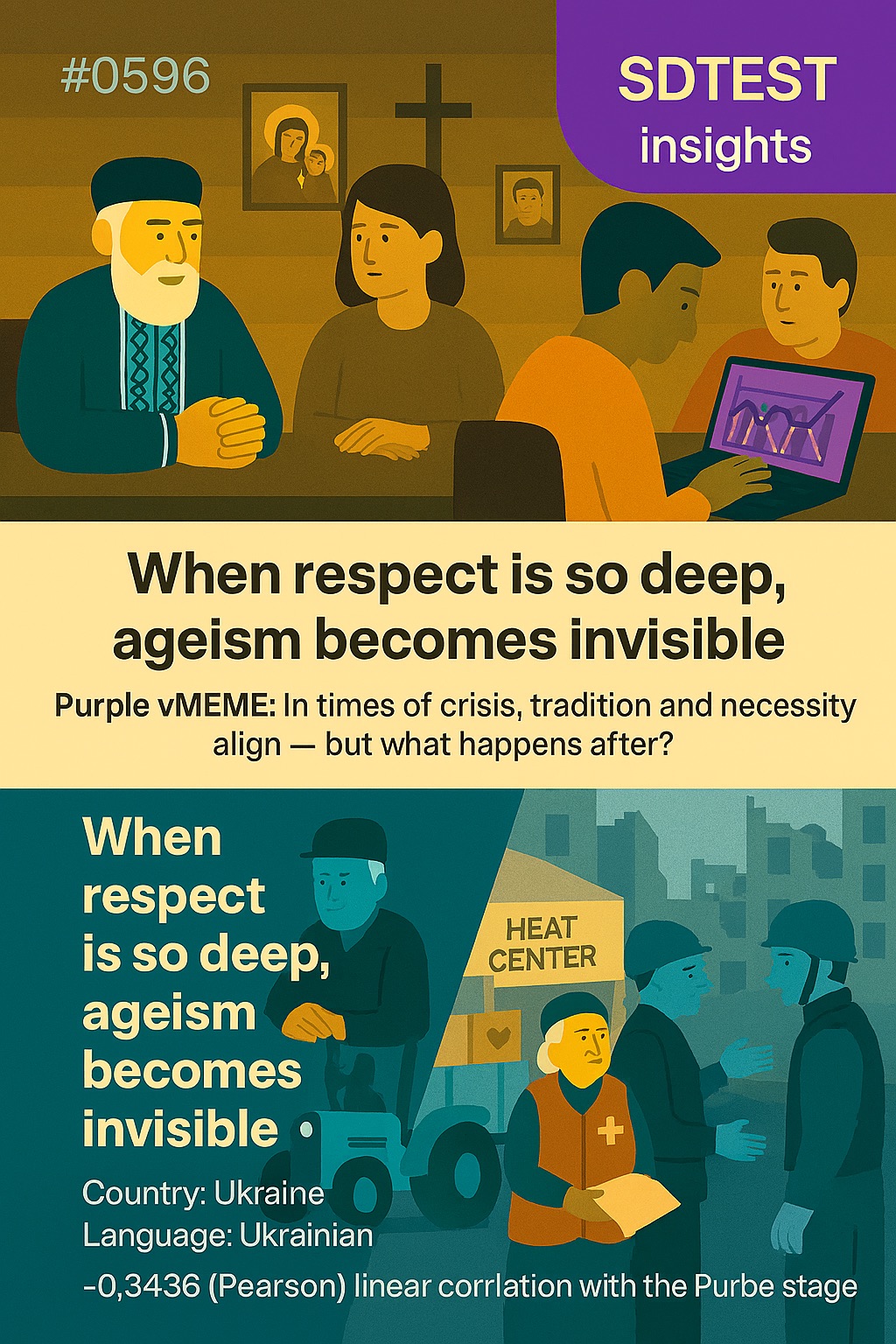
This negative correlation of -0.3436 between "I notice ageism in career" and the Purple stage (Ukraine, Ukrainian) offers profound insights when viewed through the lens of the Purple value system:
Organizational Perspective:
Organizations operating within the Purple mindset might interpret this correlation as:
- Validation of their ancestral wisdom that recognizes each life stage as carrying sacred gifts and divine purpose within the tribal community's survival and prosperity
- Confirmation that their traditional Ukrainian organizational structures honor the spiritual significance of elders while embracing the mystical energy of younger generations in harmonious collaboration
- Evidence supporting their belief that career progression follows sacred patterns and ritual cycles where age represents accumulated spiritual power rather than professional limitation
These organizations might respond by:
- Implementing traditional Ukrainian mentorship systems where elder wisdom guides younger tribal members through sacred career transitions and spiritual development
- Creating ritual ceremonies that honor different life stages as blessed phases of service to the organizational community and ancestral legacy
- Establishing hierarchical structures based on spiritual wisdom and tribal contribution rather than chronological age discrimination
Team Perspective:
Teams operating from a Purple mindset might approach this correlation by:
- Viewing it as an affirmation of their collective understanding that team members of all ages contribute unique spiritual gifts essential for the tribal community's mystical balance and survival
- Interpreting it as support for their belief that Ukrainian cultural traditions naturally integrate different generations through shared myths, rituals, and sacred purposes that transcend career-based age concerns
- Seeing it as validation for their understanding that team harmony emerges when each member fulfills their divinely-ordained role, regardless of chronological age
These teams might respond by:
- Conducting traditional Ukrainian blessing rituals that honor each team member's spiritual contribution and sacred role within the tribal work community
- Creating storytelling circles where different generations share ancestral wisdom and career guidance through mythological narratives and cultural legends
- Establishing team customs that celebrate the mystical qualities each age group brings to collective projects and tribal objectives
Individual Perspective:
Individuals aligned with the Purple value system might interpret this correlation as:
- Personal validation of their deep connection to Ukrainian ancestral wisdom that teaches career fulfillment flows from spiritual purpose rather than age-based professional advancement
- Confirmation that their traditional worldview correctly recognizes career as part of a sacred life journey guided by supernatural forces and ancestral blessings
- Evidence supporting their understanding that individual worth within the tribal community transcends chronological age and emerges from spiritual devotion and cultural contribution
These individuals might respond by:
- Seeking guidance from Ukrainian cultural elders and spiritual advisors who understand career decisions as manifestations of ancestral will and divine calling
- Participating in traditional rituals and customs that affirm their sacred value within the tribal community, regardless of professional age considerations
- Viewing career challenges through the lens of Ukrainian folklore and spiritual teachings that emphasize destiny and divine protection over age-based discrimination
This negative correlation, viewed through the Purple lens, suggests that Ukrainian individuals operating at the Purple level may be significantly less likely to perceive age-based career discrimination. It implies that the Purple value system's emphasis on spiritual purpose, ancestral wisdom, and tribal belonging creates a framework where chronological age becomes secondary to sacred community roles.
The reasons why Ukrainian-speaking people might notice ageism less in career in the Purple stage could include:
- Ancestral Reverence: Traditional Ukrainian culture deeply honors elder wisdom and recognizes each life stage as carrying unique spiritual gifts essential for community survival
- Sacred Life Cycles: Understanding career progression as part of divinely-ordained life phases where age represents accumulated spiritual power rather than professional limitation
- Tribal Integration: Strong sense of community belonging where individual worth emerges from cultural contribution and spiritual devotion rather than age-based professional categories
- Mystical Worldview: Belief that career opportunities and challenges flow from supernatural forces and ancestral guidance rather than human age discrimination
- Cultural Continuity: Ukrainian traditions that naturally integrate different generations through shared myths, rituals, and sacred purposes that transcend modern career concerns
This correlation prompts us to consider how traditional, spiritually-oriented value systems influence perceptions of age-related professional treatment. It raises questions about whether Purple-stage Ukrainian communities maintain cultural practices that naturally protect against age-based career discrimination through spiritual and tribal frameworks.
Ultimately, this correlation highlights the complex interplay between cultural heritage, spiritual beliefs, and professional experience. From a Purple perspective, the absence of career ageism might be seen not as societal blindness but as the natural result of maintaining sacred Ukrainian traditions that honor all life stages as blessed phases of service to the ancestral community and divine purpose.
In our analysis of the poll "Three Distinct Possibilities of the Future" (by Dr. Clare W. Graves), we found an intriguing positive linear correlation that warrants closer examination:
0.1193 (Pearson) between the A version of George Orwell's 1984, embodied in forms of BLUE-ORANGE-GREEN tyrannical, manipulative government with glossed over communitarian overtones and the Red stage.
The critical value of the correlation coefficient for a non-normal distribution, by Spearman, is r = 0.01. Nevertheless, this positive linear correlation of 0.1193 meets the reliability criteria but does not necessarily imply causation.
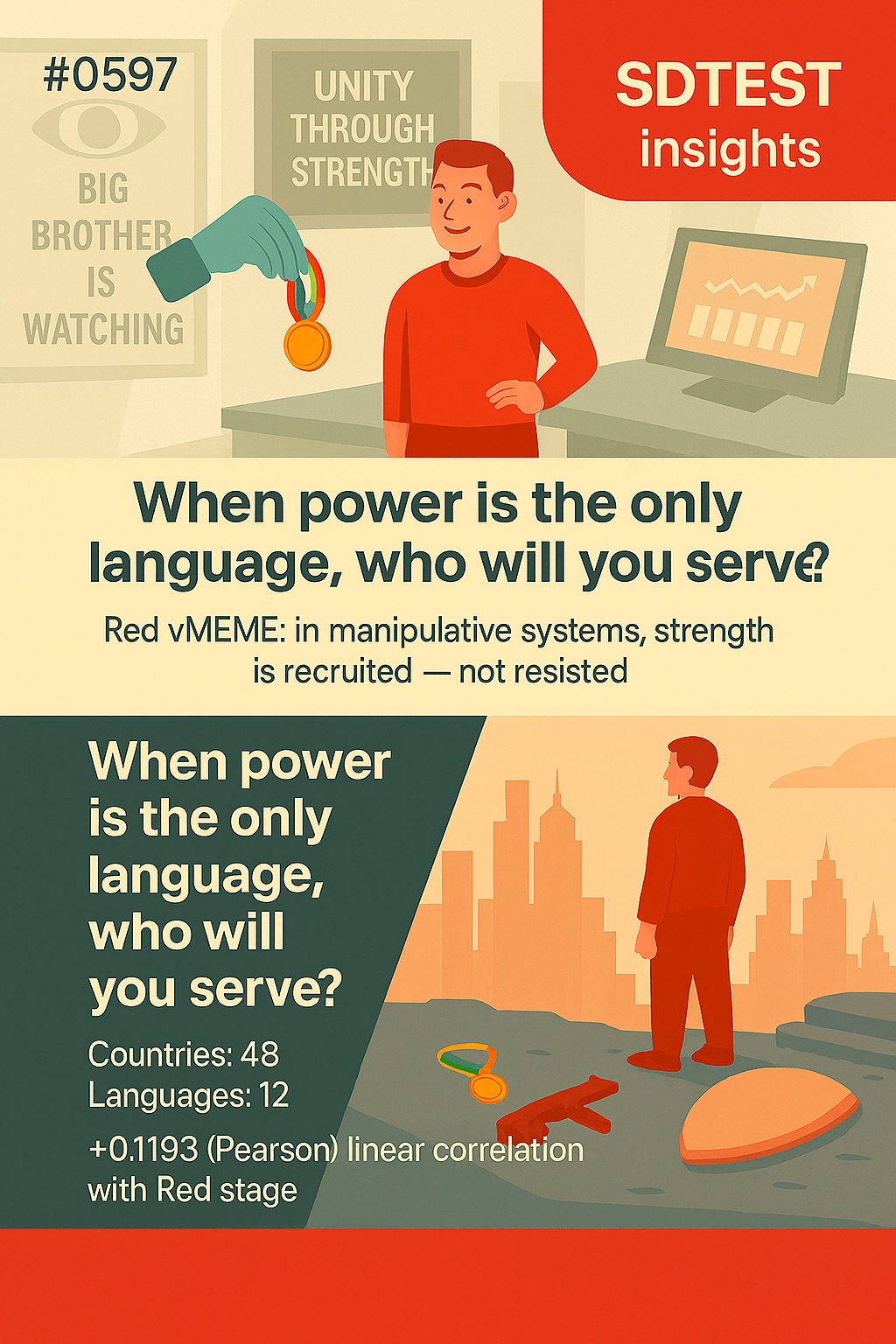
This positive correlation of 0.1193 between "A version of George Orwell's 1984, embodied in forms of BLUE-ORANGE-GREEN tyrannical, manipulative government with glossed over communitarian overtones" and the Red stage offers compelling insights when viewed through the lens of the Red value system:
Organizational Perspective:
Organizations operating within the Red mindset might interpret this correlation as:
- Validation of their instinctive recognition that systematic control threatens their ability to dominate and assert direct power over their territories and resources
- Confirmation that their aggressive, power-driven culture correctly identifies how manipulative government systems undermine individual strength and competitive advantage
- Evidence supporting their belief that bureaucratic control mechanisms represent existential threats to their capacity for immediate action and self-directed conquest
These organizations might respond by:
- Creating decentralized power structures that resist external control and maintain maximum autonomy for direct action and competitive dominance
- Implementing aggressive counter-strategies that protect organizational territory from governmental interference and regulatory manipulation
- Establishing warrior-like leadership cultures that actively resist any systematic attempts to constrain their power or dictate their operational methods
Team Perspective:
Teams operating from a Red mindset might approach this correlation by:
- Viewing it as an affirmation of their collective warrior instincts that correctly sense when external forces threaten their team's autonomy and competitive power
- Interpreting it as support for their understanding that systematic control undermines their ability to fight, win, and claim victories through direct confrontation
- Seeing it as validation for their belief that team strength emerges from resisting manipulation and maintaining the freedom to act on impulses and desires
These teams might respond by:
- Establishing fierce loyalty bonds that protect team members from external control and maintain their capacity for aggressive, independent action
- Creating confrontational strategies that actively challenge any attempts to impose systematic rules or manipulative oversight on their operations
- Developing team cultures that celebrate rebellion against authority and maintain their power to pursue immediate gratification without external interference
Individual Perspective:
Individuals aligned with the Red value system might interpret this correlation as:
- Personal validation of their instinctive rebellion against any system that threatens their individual power and freedom to express themselves without constraint
- Confirmation that their aggressive, self-centered approach correctly identifies how governmental manipulation undermines their ability to dominate and win
- Evidence supporting their understanding that systematic control represents a direct assault on their personal strength and capacity for immediate self-gratification
These individuals might respond by:
- Actively resisting any form of systematic control or manipulation that threatens their personal autonomy and power to act on impulses
- Using their dominant, assertive nature to fight against governmental systems that attempt to constrain their self-expression and competitive advantages
- Viewing the 1984 scenario as a call to arms that demands immediate, forceful resistance to preserve their individual strength and freedom
This correlation, viewed through the Red lens, suggests that those operating at the Red level may be more likely to perceive and fear Orwellian governmental control. It implies that the Red value system's emphasis on personal power, immediate gratification, and resistance to authority creates heightened sensitivity to systematic manipulation and control.
The reasons why people might see a version of George Orwell's 1984 in the future in the Red stage could include:
- Power Threat Recognition: Instinctive understanding that systematic governmental control directly threatens their ability to dominate and assert personal power
- Authority Resistance: Natural rebellion against any form of external control that constrains their freedom to act on impulses and pursue immediate desires
- Manipulation Detection: Aggressive, competitive mindset that quickly identifies attempts to control or manipulate their behavior through systematic means
- Individual Sovereignty: Strong sense of personal autonomy that perceives governmental oversight as a direct assault on their self-directed power
- Warrior Instincts: Combat-oriented mentality that recognizes systematic control as an enemy to be fought and defeated through force if necessary
This correlation prompts us to consider how power-oriented, individualistic value systems influence perceptions of governmental control and social manipulation. It raises questions about whether Red-stage individuals possess heightened sensitivity to authoritarian threats due to their fierce commitment to personal autonomy and power.
Ultimately, this correlation highlights the complex interplay between individual power drives, governmental control, and resistance psychology. From a Red perspective, fearing an Orwellian future might be seen not as paranoia but as healthy warrior instincts that correctly identify existential threats to personal strength, competitive advantage, and the fundamental freedom to dominate one's own territory without systematic interference or manipulation.
In our analysis of the poll "XING's culture assessment" [Interaction (terrible). Imagine a terrible working environment. Which aspects do you dislike the most?], we found an intriguing positive linear correlation that warrants closer examination:
0.1757 (Pearson) between the People's lack of professional distance and the Blue stage.
The critical value of the correlation coefficient for a normal distribution, by William Sealy Gosset (Student), is r = 0.1467. Nevertheless, this positive linear correlation of 0.1757 meets the reliability criteria but does not necessarily imply causation.
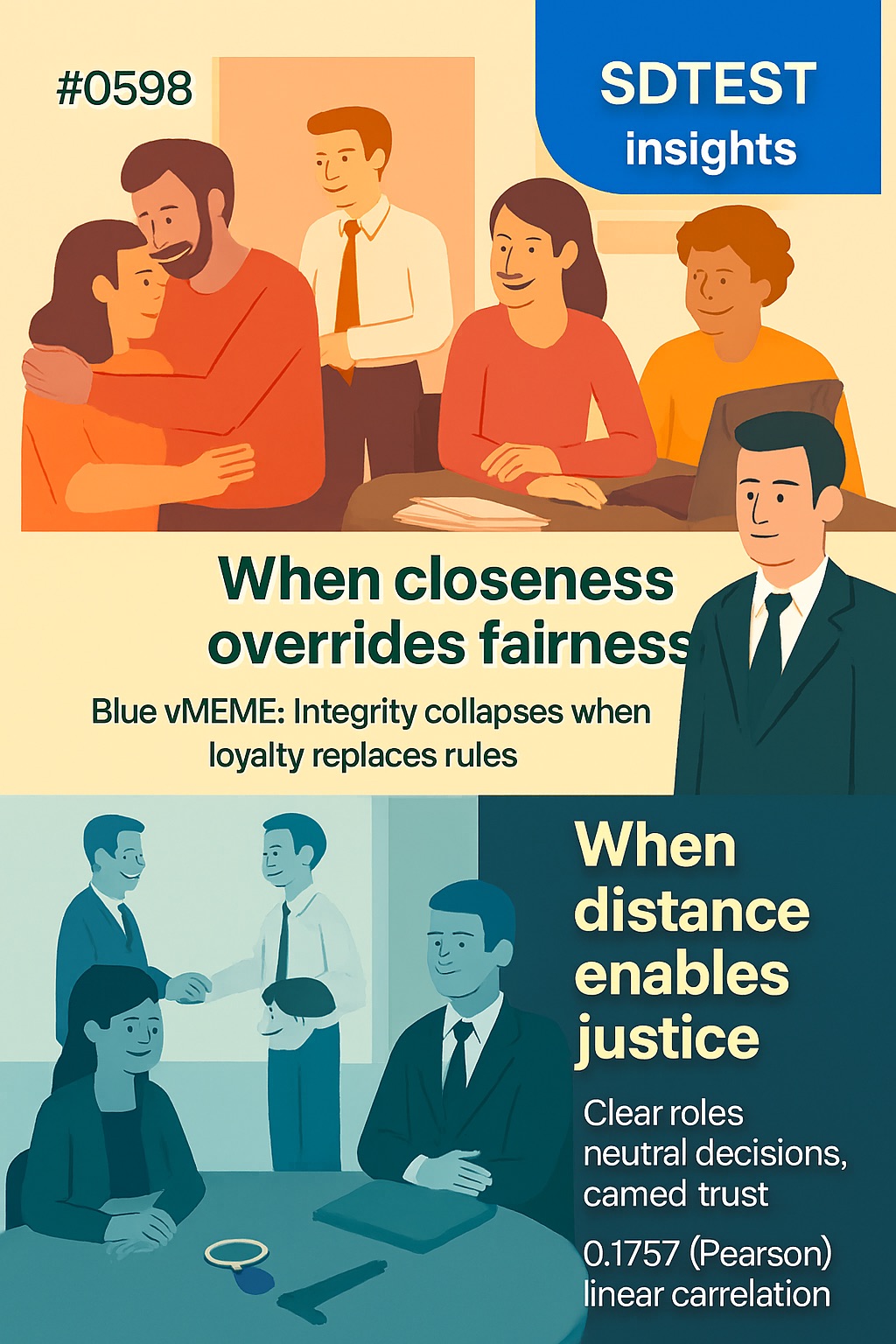
This positive correlation of 0.1757 between "People's lack of professional distance" and the Blue stage offers profound insights when viewed through the lens of the Blue value system:
Organizational Perspective:
Organizations operating within the Blue mindset might interpret this correlation as:
- Validation of their adherence to traditional hierarchical structures that maintain proper boundaries and respect for established authority chains
- Confirmation that their disciplined approach to workplace conduct preserves the sacred order and moral integrity essential for righteous organizational functioning
- Evidence supporting their belief that professional distance upholds the divine principles of duty, respect, and proper conduct handed down through institutional tradition
These organizations might respond by:
- Implementing strict codes of conduct that clearly define appropriate professional boundaries and maintain respect for hierarchical authority
- Establishing formal protocols that ensure proper distance between different organizational levels and preserve the sanctity of institutional roles
- Creating disciplinary systems that enforce traditional standards of workplace behavior and punish those who violate established professional boundaries
Team Perspective:
Teams operating from a Blue mindset might approach this correlation by:
- Viewing it as an affirmation of their commitment to maintaining proper roles, responsibilities, and respectful distance that preserves team order and moral structure
- Interpreting it as support for their understanding that professional boundaries protect the sacred trust and duty-based relationships essential for righteous teamwork
- Seeing it as validation for their belief that lack of professional distance undermines the moral fabric and disciplined conduct required for effective team service
These teams might respond by:
- Establishing clear team protocols that define appropriate professional interactions and maintain respect for established roles and authority
- Creating structured meeting formats and communication channels that preserve proper distance while enabling necessary collaboration
- Developing team codes of conduct that emphasize duty, respect, and traditional boundaries between personal and professional relationships
Individual Perspective:
Individuals aligned with the Blue value system might interpret this correlation as:
- Personal validation of their commitment to maintaining proper conduct and respectful boundaries in accordance with moral codes and traditional values
- Confirmation that their sense of duty and discipline correctly recognizes the importance of preserving professional dignity and institutional respect
- Evidence supporting their understanding that lack of professional distance represents moral failure and disrespect for sacred workplace traditions
These individuals might respond by:
- Actively maintaining appropriate professional boundaries and modeling proper conduct in accordance with established moral codes and traditional expectations
- Following strict personal guidelines that separate professional duties from personal relationships to preserve the sanctity of their institutional service
- Viewing professional distance as a moral obligation that demonstrates respect for authority, tradition, and the sacred trust placed in their organizational role
This correlation, viewed through the Blue lens, suggests that those operating at the Blue level may be particularly sensitive to violations of professional boundaries and proper workplace conduct. It implies that the Blue value system's emphasis on order, hierarchy, and moral codes creates strong expectations for appropriate professional distance and respectful workplace behavior.
The reasons why professional distance might be so important in the working environment in the Blue stage could include:
- Sacred Hierarchy: Professional distance maintains proper respect for established authority structures and divine organizational order
- Moral Integrity: Appropriate boundaries preserve the ethical standards and righteous conduct required by traditional moral codes
- Duty Preservation: Professional distance protects the sacred nature of institutional service and prevents personal relationships from corrupting professional obligations
- Traditional Order: Proper boundaries uphold time-honored workplace customs and prevent the chaos that emerges from inappropriate familiarity
- Institutional Respect: Professional distance demonstrates reverence for organizational traditions and the higher authorities that establish proper conduct standards
This correlation prompts us to consider how rule-based, traditional value systems influence expectations for workplace behavior and professional relationships. It raises questions about whether Blue-stage individuals experience particular distress when professional boundaries are violated due to their strong commitment to institutional order and moral conduct.
Ultimately, this correlation highlights the complex interplay between moral frameworks, traditional values, and workplace culture expectations. From a Blue perspective, maintaining professional distance might be seen not as coldness or formality but as a sacred duty that preserves the moral integrity, hierarchical respect, and traditional order essential for righteous organizational service and institutional preservation.
In our analysis of the poll "Psychological Wellbeing" (by Carol D. Ryff), we found an intriguing positive linear correlation that warrants closer examination:
0.1881 (Pearson) between the Purpose in life. I enjoy making plans for the future and working to make them a reality / Strongly agree, and the Orange stage.
The critical value of the correlation coefficient for a normal distribution, by William Sealy Gosset (Student), is r = 0.0471. Nevertheless, this positive linear correlation of 0.1881 meets the reliability criteria but does not necessarily imply causation.
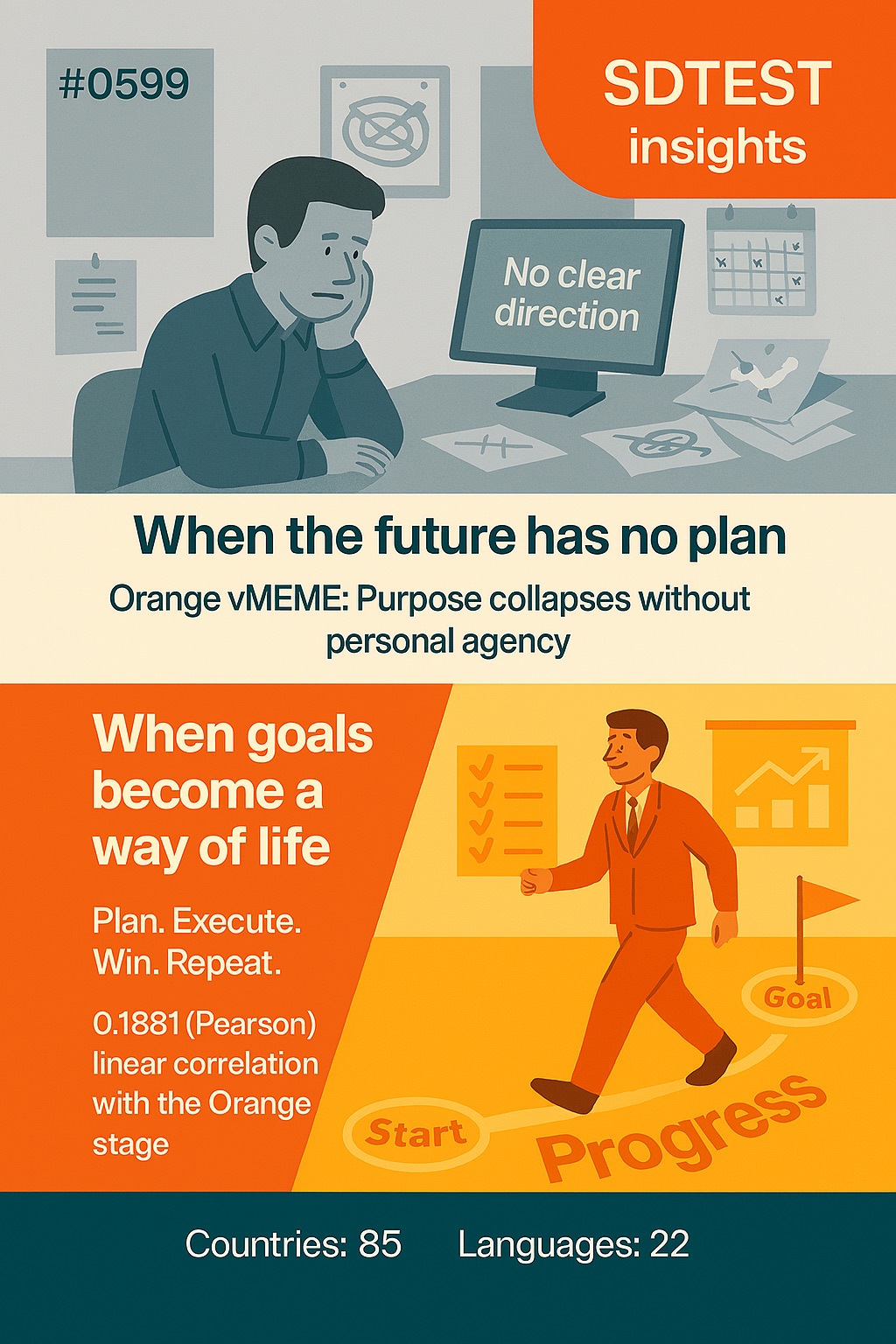
This positive correlation of 0.1881 between "Purpose in life. I enjoy making plans for the future and working to make them a reality / Strongly agree" and the Orange stage offers compelling insights when viewed through the lens of the Orange value system:
Organizational Perspective:
Organizations operating within the Orange mindset might interpret this correlation as:
- Validation of their strategic planning methodologies that utilize data-driven forecasting and evidence-based decision-making to achieve measurable business objectives
- Confirmation that their rational, goal-oriented culture naturally attracts and develops individuals who thrive on systematic progress and quantifiable achievement
- Evidence supporting their belief that scientific management principles and technological optimization create environments where future planning translates into competitive advantage and organizational success
These organizations might respond by:
- Implementing sophisticated strategic planning systems that leverage predictive analytics, market research, and performance metrics to create actionable roadmaps
- Developing comprehensive goal-setting frameworks that align individual ambitions with organizational objectives through clear KPIs and measurable outcomes
- Creating innovation labs and R&D departments that systematically transform future-oriented planning into technological breakthroughs and market opportunities
Team Perspective:
Teams operating from an Orange mindset might approach this correlation by:
- Viewing it as an affirmation of their analytical approach to project management that breaks complex objectives into measurable milestones and systematic action plans
- Interpreting it as support for their understanding that effective team performance emerges through rational planning, efficient resource allocation, and results-driven execution
- Seeing it as validation for their belief that collaborative goal-setting and systematic progress tracking maximize team productivity and achievement satisfaction
These teams might respond by:
- Establishing sophisticated project management systems that utilize scientific methodologies to track progress, optimize efficiency, and achieve ambitious objectives
- Creating competitive team environments where individual contributions to future planning are measured, recognized, and rewarded based on tangible results
- Developing data-driven planning processes that leverage team members' analytical skills and technological expertise to create innovative solutions
Individual Perspective:
Individuals aligned with the Orange value system might interpret this correlation as:
- Personal validation of their ambitious, goal-oriented approach that transforms rational analysis and systematic planning into measurable personal and professional achievements
- Confirmation that their scientific thinking and logical problem-solving naturally create fulfilling life purposes through evidence-based goal pursuit and technological mastery
- Evidence supporting their understanding that individual success emerges through strategic planning, continuous learning, and the systematic application of knowledge to achieve desired outcomes
These individuals might respond by:
- Actively developing sophisticated personal planning systems that utilize technology, data analysis, and scientific methodologies to track and achieve ambitious life goals
- Using their analytical capabilities to identify market opportunities, skill development needs, and strategic advantages that enhance their competitive positioning
- Viewing future planning as an intellectual challenge that demonstrates their rational competence and ability to transform ideas into measurable reality
This correlation, viewed through the Orange lens, suggests that those operating at the Orange level may derive particular satisfaction from systematic future planning and goal achievement. It implies that the Orange value system's emphasis on rational thinking, scientific methods, and measurable progress creates a natural alignment with structured planning processes and results-oriented execution.
The reasons why people might enjoy making plans for the future and working to make them a reality in the Orange stage could include:
- Rational Mastery: Future planning provides opportunities to apply scientific thinking and logical analysis to transform abstract ideas into concrete, measurable outcomes
- Competitive Achievement: Systematic goal-setting enables individuals to demonstrate their capabilities and achieve superior results through strategic planning and efficient execution
- Technological Optimization: Planning processes leverage scientific methods and technological tools to maximize efficiency and create innovative solutions to complex challenges
- Progress Measurement: Future-oriented goals provide quantifiable metrics that satisfy Orange-stage desires for evidence-based validation of personal and professional competence
- Individual Agency: Strategic planning reinforces beliefs in self-reliance and personal control over outcomes through rational decision-making and systematic action
This correlation prompts us to consider how scientifically oriented, achievement-focused value systems influence approaches to life purpose and goal-directed behavior. It raises questions about whether Orange-stage individuals experience enhanced psychological well-being through structured planning processes that align with their rational, results-driven worldview.
Ultimately, this correlation highlights the complex interplay between cognitive frameworks, motivational systems, and life satisfaction. From an Orange perspective, enjoying future planning and goal achievement might be seen not as mere ambition but as the natural expression of rational intelligence applied to personal development and the systematic pursuit of knowledge-based success in competitive environments.
In our analysis of the poll "Ten Keys to Motivating Your Team," we found an intriguing positive linear correlation that warrants closer examination:
0.1498 (Pearson) between the Lead by Example: Model the behavior and work ethic you expect from your team. Demonstrate a commitment to the team's success and lead with integrity, humility, and a strong work ethic, and the Green stage.
The critical value of the correlation coefficient for a normal distribution, by William Sealy Gosset (Student), is r = 0.1181. Nevertheless, this positive linear correlation of 0.1498 meets the reliability criteria but does not necessarily imply causation.
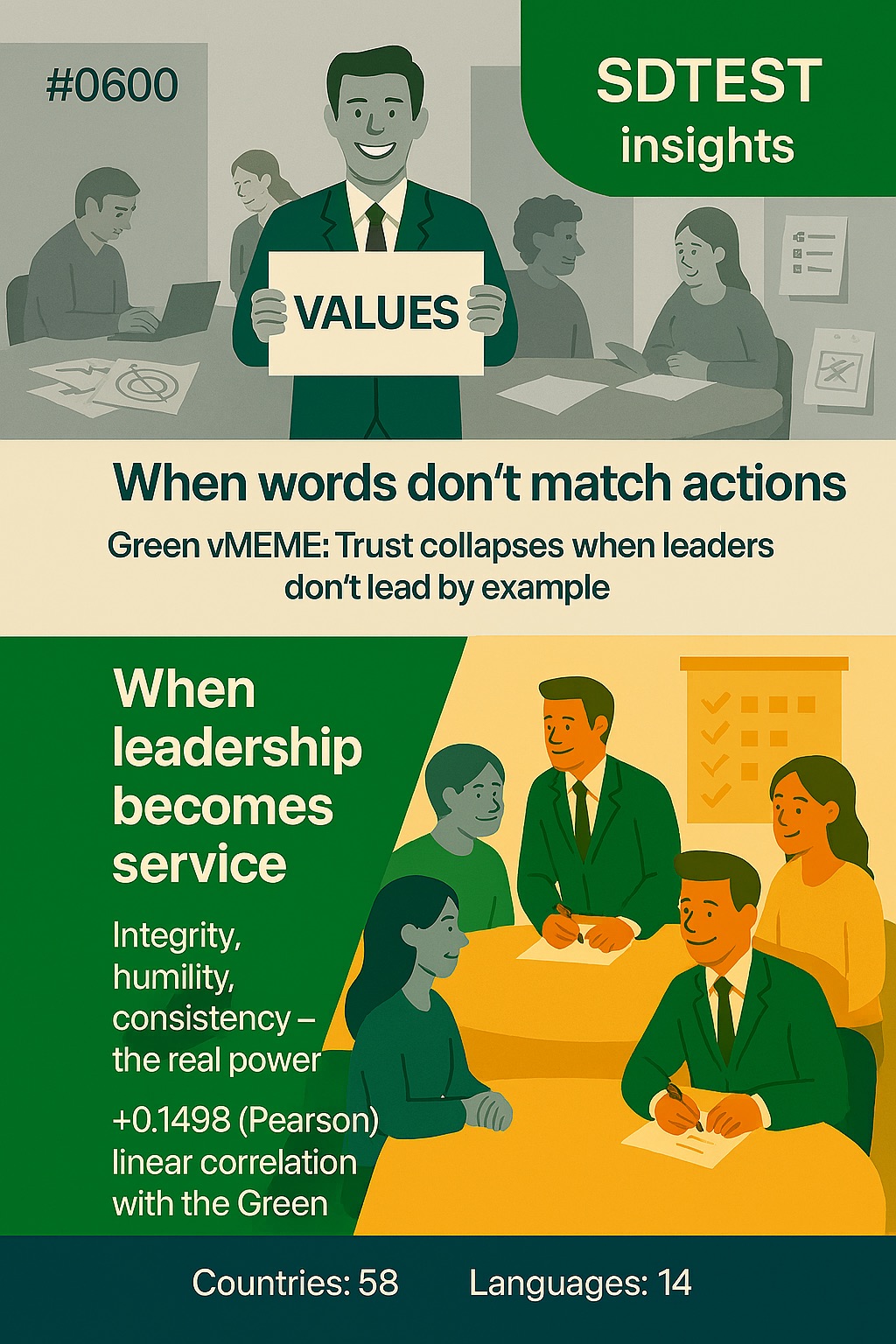
This positive correlation of 0.1498 between "Lead by Example: Model the behavior and work ethic you expect from your team. Demonstrate a commitment to the team's success and lead with integrity, humility, and a strong work ethic" and the Green stage offers profound insights when viewed through the lens of the Green value system:
Organizational Perspective:
Organizations operating within the Green mindset might interpret this correlation as:
- Validation of their authentic, values-based leadership approach that prioritizes collective well-being and sustainable practices over hierarchical power dynamics
- Confirmation that their holistic organizational culture recognizes leadership as service to the community rather than domination, requiring genuine integrity and vulnerable authenticity
- Evidence supporting their belief that sustainable organizational transformation emerges through leaders who embody the values they espouse and create psychologically safe environments for collective growth
These organizations might respond by:
- Implementing servant leadership development programs that emphasize humility, emotional intelligence, and commitment to collective flourishing over individual achievement
- Creating organizational structures that flatten hierarchies and enable leaders to model collaborative decision-making, environmental stewardship, and social responsibility
- Establishing comprehensive well-being initiatives where leaders demonstrate work-life integration and authentic care for employee holistic development and community impact
Team Perspective:
Teams operating from a Green mindset might approach this correlation by:
- Viewing it as an affirmation of their collaborative approach that requires leaders to earn trust through consistent demonstration of shared values and genuine commitment to team success
- Interpreting it as support for their understanding that authentic team unity emerges when leaders model vulnerability, inclusivity, and genuine care for each member's personal and professional growth
- Seeing it as validation for their belief that effective leadership transcends traditional authority and emerges through leaders who embody the team's collective values and sustainable practices
These teams might respond by:
- Establishing consensus-based leadership models where team members take turns demonstrating leadership through authentic service and collaborative decision-making
- Creating team rituals and practices that celebrate leaders who model emotional intelligence, environmental consciousness, and commitment to collective well-being
- Developing peer feedback systems that recognize and support leaders who consistently demonstrate integrity, humility, and genuine investment in team members' holistic success
Individual Perspective:
Individuals aligned with the Green value system might interpret this correlation as:
- Personal validation of their authentic leadership style that prioritizes genuine service, emotional transparency, and commitment to collective well-being over personal advancement
- Confirmation that their holistic approach to leadership correctly recognizes the importance of modeling the values and behaviors that create psychologically safe, inclusive environments
- Evidence supporting their understanding that meaningful leadership emerges through consistent demonstration of integrity, humility, and genuine care for others' growth and development
These individuals might respond by:
- Actively practicing vulnerable leadership that models emotional intelligence, environmental responsibility, and authentic commitment to others' success and well-being
- Using their leadership opportunities to demonstrate sustainable work practices, inclusive decision-making, and genuine investment in community building and social justice
- Viewing leadership as a sacred responsibility to embody the values of cooperation, empathy, and holistic care that create healing and transformation in organizational communities
This correlation, viewed through the Green lens, suggests that those operating at the Green level may be particularly drawn to authentic, service-oriented leadership approaches. It implies that the Green value system's emphasis on community, sustainability, and holistic well-being creates natural alignment with leadership styles that prioritize modeling values over exercising authority.
The reasons why "Lead by Example" might be particularly important for motivating teams in the Green stage could include:
- Authentic Integrity: Green-stage team members are highly sensitive to alignment between leaders' stated values and actual behaviors, requiring genuine authenticity for trust and motivation
- Community Building: Leading by example demonstrates commitment to collective well-being and models the collaborative, inclusive behaviors essential for healthy team ecosystems
- Holistic Modeling: Green-stage individuals appreciate leaders who demonstrate work-life integration, environmental consciousness, and care for the whole person rather than just productivity
- Values Alignment: Team motivation emerges when leaders consistently embody the values of sustainability, cooperation, and social responsibility that resonate with Green-stage consciousness
- Psychological Safety: Leaders who model vulnerability, humility, and genuine care create the emotionally safe environments where Green-stage team members can contribute their authentic selves and creative potential
This correlation prompts us to consider how post-modern, community-oriented value systems influence preferences for authentic, service-based leadership approaches. It raises questions about whether Green-stage individuals require higher levels of leadership authenticity and values alignment for optimal team motivation and engagement.
Ultimately, this correlation highlights the complex interplay between consciousness evolution, leadership authenticity, and team motivation. From a Green perspective, leading by example might be seen not as basic leadership competence but as an essential demonstration of the integrity, humility, and genuine care that create the conditions for collective flourishing, sustainable practices, and authentic community building in organizational settings.
0.0616 (Pearson) between the Reduced/canceled benefits (insurance, etc.) and the Yellow stage.
The critical value of the correlation coefficient for a normal distribution, by William Sealy Gosset (Student), is r = 0.0507. Nevertheless, this positive linear correlation of 0.0616 meets the reliability criteria but does not necessarily imply causation.
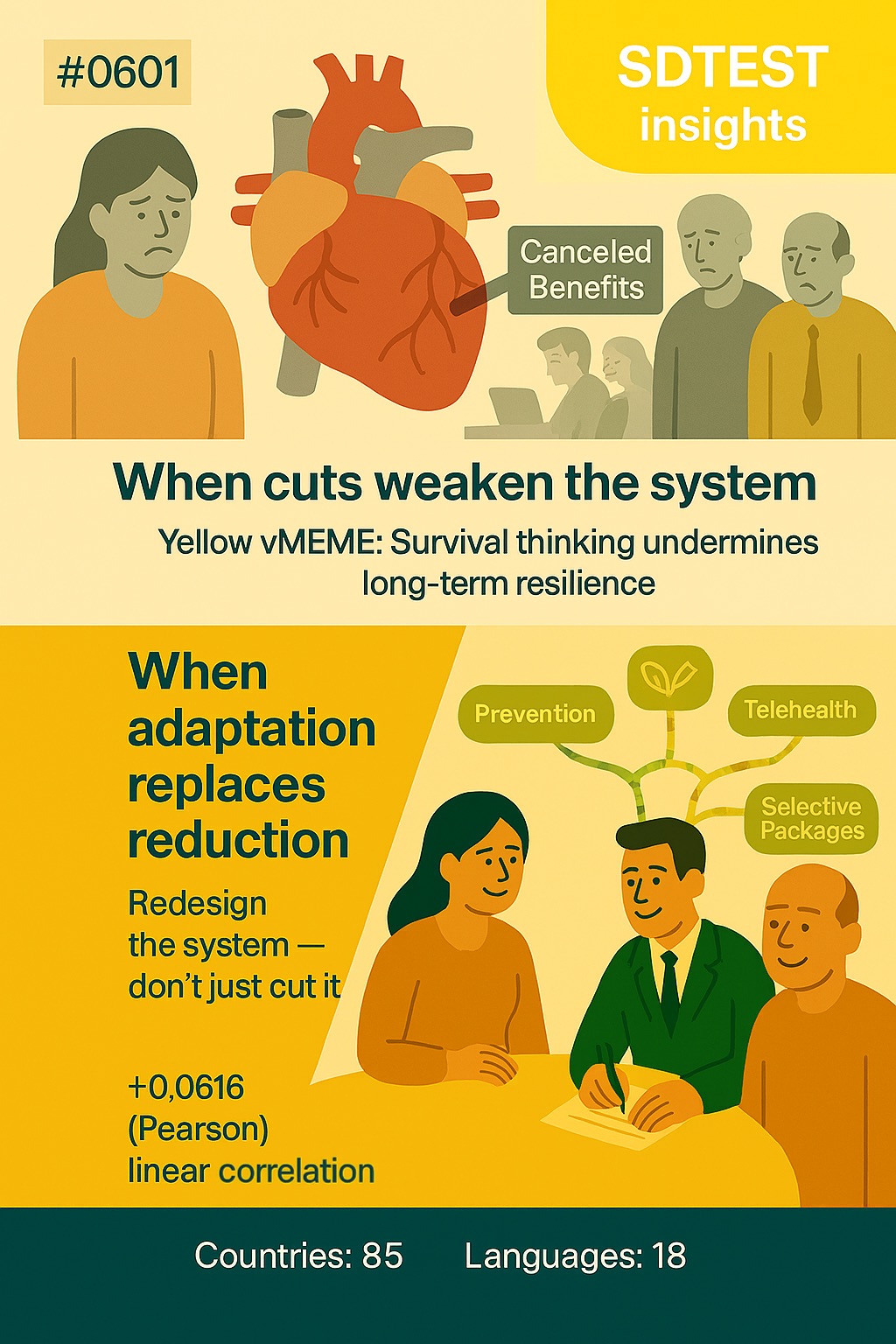
This positive correlation of 0.0616 between "Reduced/canceled benefits (insurance, etc.)" and the Yellow stage offers remarkable insights when viewed through the lens of the Yellow value system:
Organizational Perspective:
Companies operating within the Yellow mindset might interpret this correlation as:
- Validation of their integrative approach that recognizes traditional benefit structures as outdated systems requiring transformation to serve complex, evolving organizational and societal needs
- Confirmation that their meta-systemic awareness correctly identifies how conventional benefits packages may inadvertently perpetuate dependencies that limit both individual growth and organizational adaptability
- Evidence supporting their belief that sustainable organizational evolution requires transcending previous paradigms of employee-employer relationships in favor of more flexible, consciousness-supporting structures
These companies might respond by:
- Developing adaptive benefit ecosystems that integrate multiple consciousness levels and support diverse developmental pathways rather than one-size-fits-all traditional packages
- Creating experimental pilot programs that replace conventional benefits with personalized growth investments, learning stipends, and flexible wellness allocations tailored to individual evolutionary journeys
- Implementing systems thinking approaches that consider how benefit structures impact the broader ecosystem of organizational consciousness, societal evolution, and planetary sustainability
Team Perspective:
Teams operating from a Yellow mindset might approach this correlation by:
- Viewing it as an affirmation of their capacity to integrate multiple perspectives on compensation and recognize how traditional benefits may not serve the diverse developmental needs of team members at different consciousness levels
- Interpreting it as support for their understanding that effective team support requires meta-cognitive awareness of how different individuals thrive through various forms of organizational care and investment
- Seeing it as validation for their belief that authentic team evolution may require questioning inherited benefit structures that reflect outdated assumptions about human motivation and development
These teams might respond by:
- Establishing collaborative dialogue processes where team members with different consciousness levels explore alternative approaches to mutual support and collective well-being
- Creating adaptive team agreements that integrate insights from multiple value systems about what constitutes meaningful support, growth, and security
- Developing meta-frameworks that allow teams to experiment with different support models while maintaining awareness of how these changes impact individual development and collective effectiveness
Individual Perspective:
Individuals aligned with the Yellow value system might interpret this correlation as:
- Personal validation of their meta-cognitive awareness that recognizes how traditional benefit structures may reflect and perpetuate earlier-stage assumptions about security, dependence, and personal responsibility
- Confirmation that their integrative consciousness correctly identifies the complexity of benefit systems and their potential impact on individual autonomy, growth, and self-actualization
- Evidence supporting their understanding that personal evolution may require accepting increased responsibility and uncertainty in exchange for greater developmental freedom and authenticity
These individuals might respond by:
- Actively engaging in conscious dialogue about the relationship between external security and internal development, recognizing both the challenges and opportunities of reduced traditional benefits
- Using their integrative capacity to explore alternative approaches to personal security and well-being that align with their developmental journey and consciousness level
- Viewing benefit changes as opportunities for meta-learning about dependency, autonomy, and the evolving nature of work relationships in consciousness-based organizations
This correlation, viewed through the Yellow lens, suggests that organizations operating at the Yellow level may be more likely to reduce traditional benefits as part of conscious organizational evolution. It implies that the Yellow value system's capacity for integration and systems thinking creates awareness that conventional benefit structures may not serve the complex needs of evolving consciousness and organizational development.
The reasons why companies might reduce/cancel benefits in the Yellow stage could include:
- Systems Evolution: Recognition that traditional benefit structures reflect outdated paradigms that may not support the developmental needs of individuals at different consciousness levels
- Integrative Redesign: Understanding that effective organizational support requires meta-systemic approaches that transcend conventional employee-employer dependency models
- Consciousness Development: Awareness that traditional benefits may inadvertently limit individual growth by perpetuating external dependency rather than supporting authentic self-actualization
- Adaptive Flexibility: Recognition that rigid benefit packages cannot serve the diverse and evolving needs of individuals operating at different developmental stages
- Meta-Systemic Awareness: Understanding that organizational evolution requires questioning inherited structures and experimenting with approaches that serve both individual development and collective evolution
This correlation prompts us to consider how integrative consciousness influences approaches to organizational support systems and employee relationships. It raises questions about whether Yellow-stage organizations are pioneering new models of mutual support that transcend traditional benefit paradigms while serving complex developmental needs.
Ultimately, this correlation highlights the complex interplay between consciousness evolution, organizational design, and individual development support. From a Yellow perspective, reducing traditional benefits might be seen not as organizational neglect but as conscious evolution toward more sophisticated, individualized, and development-supporting approaches that honor the complexity of human consciousness and the diverse pathways of personal and collective growth.
In our analysis of the poll "Real freedom is," we found an intriguing positive linear correlation that warrants closer examination:
0.2449 (Pearson) between the Real freedom is found in being strong and powerful, able to dominate others / Disagree strongly and the Turquoise stage.
The critical value of the correlation coefficient for a normal distribution, by William Sealy Gosset (Student), is r = 0.0844. Nevertheless, this positive linear correlation of 0.2449 meets the reliability criteria but does not necessarily imply causation.
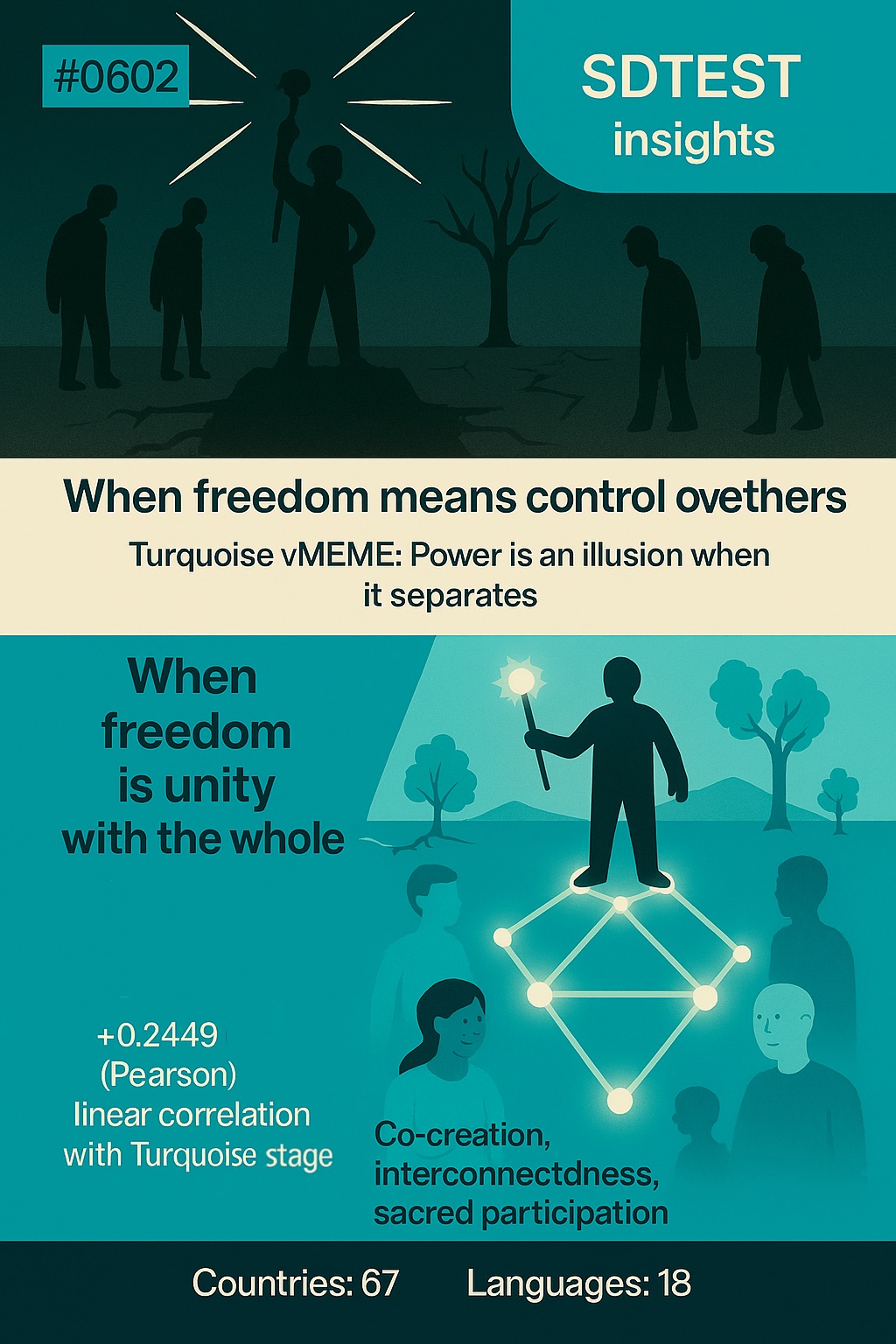
This positive correlation of 0.2449 between "Real freedom is found in being strong and powerful, able to dominate others / Disagree strongly" and the Turquoise stage offers profound insights when viewed through the lens of the Turquoise value system:
Organizational Perspective:
Companies operating within the Turquoise mindset might interpret this correlation as:
- Validation of their holistic understanding that authentic organizational freedom emerges through interconnected ecosystems of mutual support rather than hierarchical domination and power-based control structures
- Confirmation that their ecological approach correctly recognizes how domination-based models fragment the sacred web of relationships essential for regenerative organizational health and planetary well-being
- Evidence supporting their belief that true organizational liberation flows from alignment with natural systems where cooperation, symbiosis, and collective flourishing replace competitive dominance paradigms
These companies might respond by:
- Developing biomimetic organizational structures that mirror natural ecosystems where freedom emerges through interdependent relationships and regenerative cycles rather than extractive power dynamics
- Implementing sacred stewardship models that recognize organizational success as service to the greater web of life, transcending profit-driven domination in favor of planetary healing and collective awakening
- Creating contemplative decision-making processes that honor the interconnectedness of all stakeholders, including future generations and non-human life, ensuring organizational freedom serves universal flourishing
Team Perspective:
Teams operating from a Turquoise mindset might approach this correlation by:
- Viewing it as an affirmation of their deep understanding that team liberation emerges through honoring the sacred interconnectedness that connects all members in ways that transcend individual power dynamics
- Interpreting it as support for their recognition that authentic collaborative freedom flows from unity consciousness, where individual expression serves collective evolution and planetary healing
- Seeing it as validation for their belief that team empowerment requires transcending ego-based dominance patterns in favor of wisdom-guided service to the greater evolutionary unfolding
These teams might respond by:
- Establishing contemplative practices that attune team members to the subtle energetic fields and spiritual connections that enable collective wisdom to emerge through collaborative consciousness
- Creating sacred spaces for deep listening where team freedom is experienced as participation in the larger cosmic evolution rather than individual assertion of power over others
- Developing consensus-based approaches that honor the divine spark in each team member while serving the team's higher purpose of contributing to planetary transformation
Individual Perspective:
Individuals aligned with the Turquoise value system might interpret this correlation as:
- Personal validation of their profound recognition that authentic freedom emerges through surrendering to the sacred flow of universal consciousness rather than asserting dominance over the interconnected web of existence
- Confirmation that their ecological awareness correctly identifies how power-based freedom creates separation illusions that fragment their connection to the cosmic wholeness that is their true nature
- Evidence supporting their understanding that genuine liberation flows from aligning with the evolutionary impulse of the universe rather than dominating other expressions of the sacred life force
These individuals might respond by:
- Engaging in spiritual practices that dissolve the ego-boundaries that create illusions of separation and power-based freedom, opening to their identity as expressions of universal consciousness
- Using their holistic awareness to recognize how domination-based freedom perpetuates the disconnection and ecological destruction that harms the planetary community they are part of
- Viewing true freedom as conscious participation in the sacred evolution of cosmos, where individual expression serves the healing and awakening of all life
This correlation, viewed through the Turquoise lens, suggests that those operating at the Turquoise level profoundly reject domination-based concepts of freedom. It implies that the Turquoise value system's emphasis on interconnectedness and ecological awareness creates a deep understanding that authentic freedom emerges through unity consciousness rather than power-over dynamics.
The reasons why people might strongly disagree that "Real freedom is found in being strong and powerful, able to dominate others" in the Turquoise stage could include:
- Unity Consciousness: Deep recognition that true freedom emerges through experiencing one's interconnectedness with all life rather than creating artificial separation through domination
- Ecological Wisdom: Understanding that power-based freedom reflects the same destructive patterns that are fragmenting planetary ecosystems and preventing collective healing
- Sacred Interconnectedness: Awareness that dominating others fragments the web of relationships that sustains both individual well-being and cosmic evolution
- Evolutionary Perspective: Recognition that authentic freedom involves serving the greater evolutionary unfolding of consciousness rather than asserting individual power over others
- Cosmic Identity: Understanding that true liberation flows from recognizing oneself as an expression of universal consciousness rather than a separate entity seeking dominance
This correlation prompts us to consider how post-integral consciousness experiences the relationship between freedom and power in interconnected reality. It raises questions about whether Turquoise-stage individuals have transcended power-based paradigms in favor of freedom models rooted in unity consciousness and ecological awareness.
Ultimately, this correlation highlights the complex interplay between consciousness evolution, freedom concepts, and interconnected reality. From a Turquoise perspective, rejecting domination-based freedom might be seen not as powerlessness but as profound wisdom that recognizes authentic liberation emerges through conscious participation in the sacred web of existence, where individual freedom serves the flourishing of the entire planetary community and cosmic evolution.
What insights do you gain from today's correlation? How might we study this relationship more carefully before deducing causation?
We welcome respectful and wise perspectives! Stay tuned every week as we share more results and insights.
After login or registration, free access to the poll results in the FAQ section.
2025.08.24
FearpersonqualitiesprojectorganizationalstructureRACIresponsibilitymatrixCritical ChainProject Managementfocus factorJiraempathyleadersbossGermanyChinaPolicyUkraineRussiawarvolatilityuncertaintycomplexityambiguityVUCArelocatejobproblemcountryreasongive upobjectivekeyresultmathematicalpsychologyMBTIHR metricsstandardDEIcorrelationriskscoringmodelGame TheoryPrisoner's Dilemma
Valerii Kosenko
Pwopriyetè pwodwi SaaS SDTEST®
Valerii te kalifye kòm yon pedagòg sosyal-sikològ an 1993 e depi li te aplike konesans li nan jesyon pwojè.
Valerii te jwenn yon diplòm Mèt ak kalifikasyon manadjè pwojè ak pwogram nan ane 2013. Pandan pwogram Mèt li a, li te vin abitye ak Pwojè Roadmap (GPM Deutsche Gesellschaft für Projektmanagement e. V.) ak Spiral Dynamics.
Valerii se otè a nan eksplore ensètitid la nan V.U.C.A. konsèp lè l sèvi avèk dinamik espiral ak estatistik matematik nan sikoloji, ak 38 biwo vòt entènasyonal yo.








